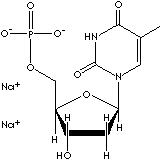PRODUCT IDENTIFICATION
33430-62-5 (Disodium)

H.S. CODE
TOXICITY
CLASSIFICATION
PHYSICAL AND CHEMICAL PROPERTIES
REFRACTIVE INDEX
Stable under ordinary conditions. Hygroscopic.
GENERAL DESCRIPTION & APPLICATIONS
Thymine is a pyrimidine base, occurring condensed with deoxyribose to form the nucleoside deoxythymidine in animal cells. Thymidine is significant because of its involvement in the biosynthesis of DNA and in the preservation and transfer of genetic information. It was thought that there is no thymine in ribonucleic acid (RNA); the thymine nucleotides contain only deoxyribose. However, It is now known that thymine, produced from uracil by post-transcriptional methylation, occurs as a rare base in rRNAs and tRNAs. When N1 is linked to the C1 of ribose, thymine forms a pyrimidine nucleoside called thymidines which are phosphorylated with from one to three phosphoric acid groups to form the three nucleotides; thymidine monophosphate(TMP), thymidine diphosphate(TDP), and thymidine triphosphate (TTP) respectively. TTP is involved in the formation of adenosine triphosphate (ATP) as a donator of phosphate groups to adenosine diphosphate (ADP).
- Thymine: a pyrimidine base
- Thymidine: a pyrimidine nucleoside
- Thymidine Monophosphate (TMP, Thymidylic acid): a nucleotide, the 5'-phosphate of thymidine
- Thymidine dDphosphate (TDP): a nucleotide, the 5'-pyrophosphate of thymidine
- Thymidine Triphosphate (TTP): a nucleotide, the 5'-triphosphate of thymidine
- Deoxythymidine Monophosphate (dTMP), a nucleotide, the 5'-phosphate of deoxythymidine. (deoxy-, also called desoxy, is a prefix for the designation of compounds which contain one less atom of oxygen than the reference substance).
- Deoxythymidine Diphosphate (dTDP), a nucleotide, the 5'-pyrophosphate of deoxythymidine.
- Deoxythymidine Triphosphate (dTTP), a nucleotide, the 5'-triphosphate of deoxythymidine; a precursor in the synthesis of deoxyribonucleic acid.
Chemically modified nucleotides substituted or attached by special chemical groups or elements are studied and used to inactivate the normal biological operation in the living organism and the function of important enzymes.
APPEARANCE
98.0% min
0.71 - 0.73 (A280/A260)
HEAVY METALS
10ppm max